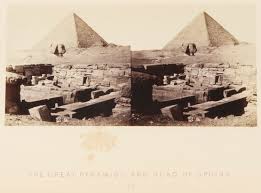|
Two separate images are printed side-by-side. When viewed without a stereoscopic viewer the user is required to force his eyes either to cross, or to diverge, so that the two images appear to be three. Then as each eye sees a different image, the effect of depth is achieved in the central image of the three.
|
|
The pictures used in the stereo views where in the form of "stereographs" which were two pictures of the same scene that were slightly offset and mounted side-by-side. In the 1850s the production of stereographs, also called stereograms, was in high gear and a very popular item.
|
Pictures from around the world, of everything from prominent public people to war scenes were made available. One of the main sources was the Keystone View Company who advertised exotic pictures and capitalized on the 3D illusion of stereo viewing. The company advertised the quote of Carl Sandberg, "the best substitute for intelligent travel is intelligent use of stereographs.", to promote the use of stereo viewing as a way to see the world.
|
In the mid-20th century the View-Master stereoscope (patented 1939), with its rotating cardboard disks containing image pairs, was popular first for 'virtual tourism' and then as a toy.
|




